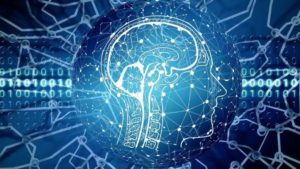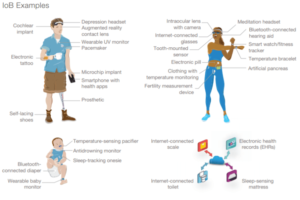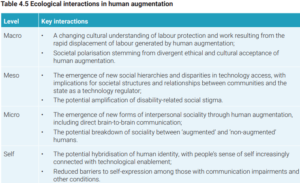RAND Corporation: “Internet of Bodies Can Lead to Internet of Brains by 2050”
The “Internet of Bodies” ecosystem could lead to the “Internet of Brains” sometime between 2035 and 2050, according to a RAND report commissioned by the UK Ministry of Defense.
Commissioned by the UK Defense Science and Technology Laboratory and conducted by RAND Europe and Frazer Nash Consulting, the study Cultural and technological change in the future information environment looks at six technologies and information environments and their impact on British defense.

This includes:
- Automated information systems
- A virtual metaverse
- Augmented and mixed reality
- Advanced connectivity
- Human augmentation
- Information security
An important theme that runs through these information environments is transhumanism – the merging of humans and machines.
The report states: “Advances in connecting objects could eventually extend to the human body. Researchers are calling the potential development of an Internet-connected network of human-connected devices that collect end-user biometric data the ‘Internet of Bodies’ […] An ‘Internet of Bodies’ may ultimately also become an ‘Internet of Brains’, that is, human brains connected to the Internet to facilitate direct brain-to-brain communication and provide access to online data networks.”
The Internet of Bodies and the upcoming Internet of Brains fall under the category of “human enhancement technologies,” which refers to technologies that enhance human capabilities either physically or cognitively.
According to the report, the technological applications most associated with human augmentation include:
Wearable devices and implants for monitoring and analyzing physiological and environmental data (e.g. biochips and implantable sensors). These technologies aim to continuously monitor physiological data in real time to understand human health and performance.
Sensory enhancement technologies such as hearing and retinal implants to improve or expand sensory activities, particularly vision and hearing. Smart prosthetics are a related category, including exoskeletons, which are full-body robotic suits that enhance end-users’ physical abilities and increase their mobility, strength, endurance and other abilities.
Brain-computer or brain-brain interfaces, which establish direct communication between human brains and/or computing devices.
Elon Musk’s Neuralink is the latest example of a brain-computer interface that gained a lot of attention after being implanted in a paralyzed man. But what occurs when human augmentation goes from healing to enhancing?
Transhumanism may lead to superhuman abilities, but these abilities could only be reserved for a select class, while the rest of us programmable rabble could live in a constant state of surveillance and control until we become irrelevant.
The report states: “While some experts predict a tactical improvement in human capabilities, others have explored the possible emergence of transhumanism in 2050.”
This concept describes “a new form of human being in which information and communication technologies and biomedicine will fundamentally improve the human condition and significantly increase human intellectual, physical and psychological capabilities.”
The Chosen Ones could receive a human performance enhancement, giving them the ability to never tire, think smarter, move faster, jump higher, see farther, hear better, hit harder, live longer, adapt more, and to calculate faster than any other person on the planet.
Meanwhile, the fourth industrial revolution is already merging our physical, biological and digital identities to monitor, manipulate and reprogram our behavior.
When humans fully merge with machines on a large scale, where does technology end and humans begin?

The authors of the RAND report note that “given the direct embedding of technology into human cognitive, physical, and psychological functioning, significant levels of human augmentation are blurring notions of identity and humanity, introducing new normative lenses on being human, and can lead to new stigmatization of those who do not meet these standards”.
On a personal level, if one wishes to remain a natural human and not become part of the Homo technologicus, one could be uncompetitive in the workplace and belong to a useless class of people.
On an international level, countries, cultures and communities that do not participate in the transhumanist experiment could easily be conquered by those that do.
The report adds: “The social dynamics surrounding the adoption of human augmentation can lead to inequalities in access to the relevant technologies, creating new forms of digital exclusion in which the economically disadvantaged cannot achieve the same levels of augmentation as other segments of society.”
At the same time, natural people who cannot be chipped have the advantage of not being easily manipulated and controlled by thoughts or memories that are not entirely their own.
In other words, transhumanism can lead to superhuman abilities for some and consciousness control for others.

Manipulation and control are other areas of concern in human augmentation, the Internet of Bodies, and the Internet of Brains.
False information, images, sounds, memories and thoughts could one day be downloaded onto these devices and uploaded into the human brain with devastating effect.
The report states: “Sensing technologies (e.g. hearing implants) in particular are at risk of interference, where the devices could be manipulated to provide incorrect information to the end user.”
Such sensory manipulation would significantly increase the current threats posed by artificially created or manipulated visual and auditory information (e.g. images and videos).
“Therefore, human augmentation could undermine the cognitive security of end users and affect their ability to assess the credibility of the information they receive when using human augmentation technologies.”
yogaesoteric
April 22, 2024
